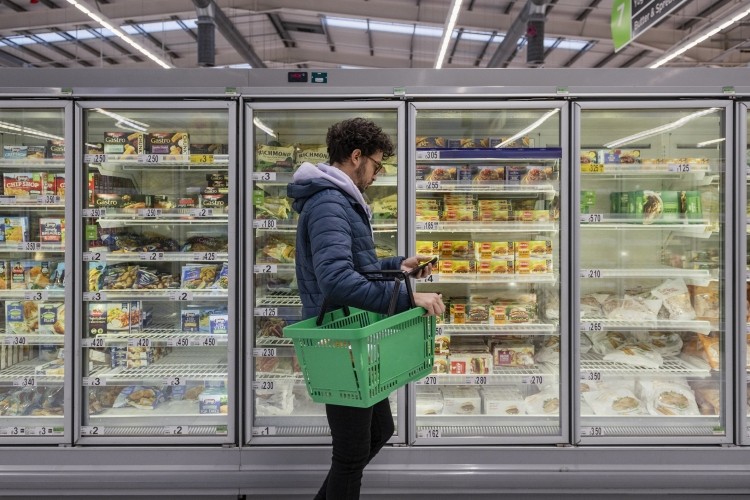Frozen food prices up 17% vs. 2021, but consumers still believe it provides good value, says Acosta

The average price per unit in the frozen food department increased 17% to $4.91 in September 2022 vs. September 2021, and up 31.6% vs. 2019, according to IRI sales data.
The increase tracks ahead of total store level inflation, which was +14.3% in September 2022 vs. one year ago.
Frozen categories with the largest year-over-year per unit price increase (September 2022 vs. September 2021) included fruits and vegetables (+19.2%), snacks (+19%) meals (+18.8%), and meat/poultry/seafood (+17.9%).
Only one area, frozen beverages, averaged a single-digit (+7.1%) year-over-year price increase.
Total food & beverage sales (measured channels, retail, IRI) were up +9.5% YoY in September 2022, with units down -4.1%, while frozen sales were up +9.7% with units down -6.2%.
Big CPG and frozen food
Large players such as Conagra Brands (Bird’s Eye, Marie Callender’s, Banquet, Healthy Choice) and General Mills (Häagen-Dazs, Totino’s) have reported strong sales in its frozen foods portfolios and investment into its frozen food offerings.
“Frozen generated a significant acceleration of quarterly sales growth on a one and three year basis of 8% and 27% respectively. Clearly, our focus on catering to consumer preferences for convenience, quality and great taste continue to resonate,” said Conagra president and CEO Sean Connolly on the company’s Q1 2023 earnings call.
In August 2022, General Mills announced a $100m investment at one of its manufacturing plants making Totino’s frozen pizza products.
Earlier this year, Nestlé USA-owned Sweet Earth Foods expanded its frozen foods line to meet demand for convenience and plant-based nutrition.
Acosta: Consumers still believe frozen provides better value
But even as the average unit price for frozen products has risen by double digits vs. one year ago, consumers continue to select frozen products as a key part of their food shopping experience, noted Kathy Risch, SVP, consumer insights and trends at Acosta.
“We’ve found that criteria for purchase are balanced between the requirements of affordability and value, healthy choices that meet dietary or lifestyle needs, convenience of preparation and a bit of comfort,” said Risch.
Acosta found that 98% of households purchase frozen with 86% of those shoppers visiting the frozen section on all or most of their grocery visits.
While 93% of shoppers are noticing higher prices on frozen foods, 67% of consumers still believe that frozen sometimes provides a better value than non-frozen in specific categories of vegetables, fruit, meat, fish, and pizza and 40% of shoppers are spending more time looking for deals in the frozen food aisle, according to Acosta research.
Part of deal hunting is being done at club stores where shopping for frozen foods has jumped 5% this year, with 52% of households reporting they’re buying in bulk to save money, Acosta found.
In addition, consumers’ frozen food purchases are often planned vs. impulse decisions, and consumers often prefer to purchase frozen foods in-store vs. online citing handling concerns as a key barrier.
When it comes to what consumers are seeking out and buying in the frozen foods aisle, 91% are purchasing desserts to satisfy cravings for comfort, convenience, and indulgence.
Many (89%) of consumers are purchasing prepared foods and 59% of consumers replaced a frozen main dish as a replacement for eating outside the home. Three-quarters purchased vegetables as frozen vegetables are often perceived as a better value than fresh, noted Acosta.
Invest in the frozen foods aisle
To capitalize on consumers’ allegiance to the frozen foods aisle, Acosta recommends manufacturers and retailers invest in their frozen food sets with clear marketing and packaging communication on the value proposition of frozen foods, especially bulk items and entrees.
“Highlight the convenience of meal solutions and communicate dinner meal solutions that mix and match frozen with fresh items,” noted Acosta.
Health messaging should also be front and center with retailers and brands promoting the healthy nutritional content preserved in frozen foods and elevate options with healthier innovation such as introducing more plant-based options.
Acosta also advises retailers to make the freezer section a more fun, enjoyable, and engaging shopping experience for consumers.
“There is an opportunity to do more to engage with customers and drive excitement and purchase in the frozen section, in-store and online, through targeted omnichannel marketing, sales promotions and experiential retailing. Understanding the consumer mindset in frozen will play an important role in supporting anticipated growth and driving purchase decisions,” said Risch.




















